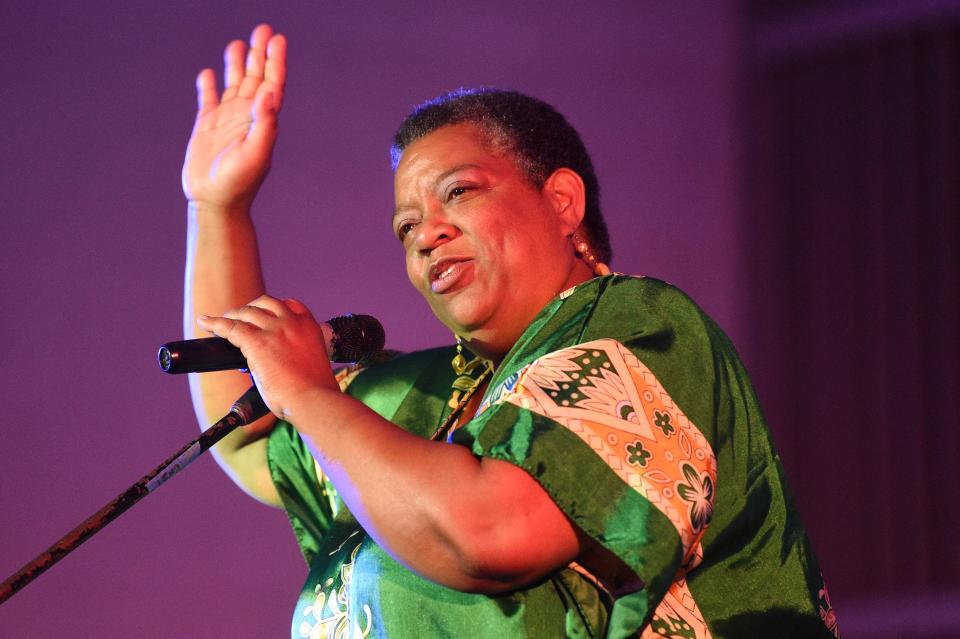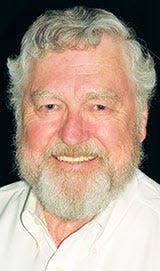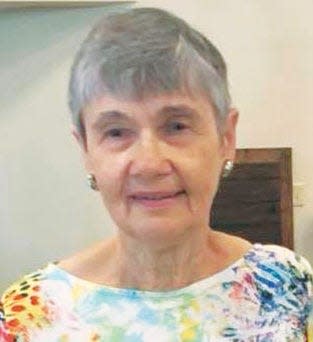Storyteller to dramatize the historical desegregation of Oak Ridge Schools
Carolyn Krause brings us news of an upcoming week of special programs by acclaimed professional Black storyteller Sheila Arnold who returns to Oak Ridge to retell the Scarboro 85 story she first dramatized at the Flatwater Tales Storytelling Festival in early June 2022 in the Historic Grove Theater. She will speak here nine times in February about the first historic desegregation of schools in the Southeast that took place in 1955 at Oak Ridge High School and Robertsville Junior High School.

The storyteller will give four free public performances Feb. 20-23 at different Oak Ridge venues during Black History Month. The festival committee had commissioned her in 2021 to develop and relate the story in 2022. She conducted research and interviewed members of the Scarboro 85.
Thanks to a grant the Flatwater Tales Committee received from the Tennessee Arts Commission and matching funds from a patron, "Ms. Sheila," as she is known on the national storytelling circuit, will dramatically portray the experiences of a few of the 85 Black students who obeyed a federal government order to desegregate two all-white Oak Ridge schools beginning on Sept. 6, 1955.
“These events will help us get support for creating a spectacular monument to tell the story of the Scarboro 85 and make this great story an official part of the Tennessee History curriculum,” said John Spratling, a Black social studies teacher and coach at Robertsville Middle School for almost 30 years. John is the school’s winningest boys’ basketball team coach. He is leading this effort along with Rose Weaver, local Black historian, to commemorate the historical Scarboro 85 accomplishment.
Enjoy Carolyn’s news and plan to attend at least one of the public events See poster for the dates, times, and locations.
***
Imagine that you and 84 other students in your school, who all have the same skin color, were ordered by the U.S. government to leave your beloved school, where every teacher and student knows you. You have been told to start attending another school in which 1,400 students you don’t know have a different skin color. Might you find that to be a traumatic experience?
This not-well-known desegregation of two schools happened in Oak Ridge beginning on Sept. 6, 1955. Ten years before, it was revealed that the Secret City of Oak Ridge had supplied enough fuel enriched in uranium to make an atomic bomb that helped win World War II. But Oak Ridge had another secret that has been unveiled and publicized only recently: the city was the site of the first desegregation of schools in the Southeast. It was one of the first major civil rights victories in mid-20th-century American history, but there were no headlines, just trauma and good intentions.
The reason for the event: the U.S. Atomic Energy Commission issued an order to desegregate Oak Ridge High School (ORHS) and Robertsville Junior High School in response to the landmark 1954 U.S. Supreme Court ruling in the Brown vs. Board of Education case. The highest court decided that separating children in public schools because of race was unconstitutional.
This desegregation of two Oak Ridge schools by 85 African-American youths who had attended the Scarboro School preceded the more famous school desegregation cases: the "Clinton 12" at Clinton High School (Aug. 26, 1956), the Little Rock Nine at Little Rock Central High School (1957) and Ruby Bridges, the six-year-old Black girl who passed a test, enabling her to enroll in 1960 in the all-white William Frantz Elementary School in New Orleans.
The historical Scarboro 85 desegregation of two schools is an important story that needs to be told and was told in a poignant, informative way by Sheila Arnold, a master storyteller in June 2022 in Oak Ridge.
It will be told by her nine times again in February.
Imagine the fears felt by the Scarboro 85 students and their parents in early September 1955. Just a few days earlier, on Aug. 28, a 14-year-old Black boy named Emmett Till had died after being abducted, tortured and lynched in Mississippi because a white woman accused him of whistling at her in her family’s grocery store.
Be aware that two of the Scarboro 85 were tall, talented basketball players on the Oak Ridge High School varsity team in late fall of 1955. These players, Fred Guinn and Lawrence Graham, had to endure the emotional pain of phone calls telling them to stay home because an opposing high school team refused to play an ORHS team with a Black player on the court. But on Dec. 3, 1955, they became pioneers for sports desegregation by playing a few minutes with the ORHS team against the all-white Powell Valley High School team, which won by two points. This groundbreaking game received coverage in the New York Times.
John Spratling, a Black social studies teacher at Robertsville Middle School (RMS) for almost 30 years, who recently became the school’s winningest boys’ basketball team coach, said, “I credit the Scarboro 85 and basketball players Fred Guinn, Dr. Ahmed Alhamisi (formerly Lawrence Graham) and Robert Berry for their sacrifices made for me and all of us back in 1955. Without them there is no me!”
That’s why Spratling and Rose Weaver, local Black historian, are leading an effort to get a monument built to commemorate the historical Scarboro 85 accomplishment.
Or imagine being Archie Lee, the first Black student inducted into the National Honor Society at Oak Ridge High School. As a physics class student, he was the only Black kid on the bus trip to a missile facility in Huntsville, Alabama. When the group stopped at a restaurant, he was told he would not be served. So, the tour group left the restaurant and found another one willing to serve everybody.
Pat Postma, a senior at ORHS in 1955, has been working with Spratling and Weaver on the Scarboro 85 Monument Committee.
“I understand that those of us with white skin can never appreciate what it feels like to be inside a black skin,” she said. “What may appear to be a peaceful transition may often include invisible and hurtful discrimination such as a white teacher who never recognizes a black hand raised in her class, a hateful slur whispered when a Black student passes by in the hallway or a shove in the stairwell.”
Postma’s father, Thomas Dunigan, was ORHS principal in 1955. Her family endured a shocking experience during that school year: a small cross burning on their front lawn.
Concerning the desegregation event, Postma added, “My father’s message to our family and to the community was the same: ‘We are not doing this because we are being forced to do it; we are doing this because it is the right thing to do.’
“I can say that the friends I spent time with felt the same way. We truly wanted this desegregation to be a success. I remember many of us standing by the front door that day as the Black students arrived. We genuinely welcomed them to join us," she said.
One of the best ways to highlight the significance of and personal emotional experiences of this historical civil rights event is to have the story told by a nationally acclaimed professional Black storyteller.
"Ms. Sheila," as she is known on the national storytelling circuit, first told the Scarboro 85 story at the Flatwater Tales Storytelling Festival held in early June 2022 in the Historic Grove Theater in Oak Ridge. The festival committee had commissioned her in 2021 to develop and relate the story in 2022. She conducted research and interviewed members of the Scarboro 85.
She dramatically portrayed a few of the Scarboro 85 students “who left a school where they were loved and nurtured to catch buses to go where they were, by and large, merely tolerated in the hallway, in classes and even at the prom,” said Martha Hobson, co-chair of the Flatwater Tales Storytelling Festival committee.
“When Ms. Sheila tells this story, it becomes so real that you can smell the fumes from those old 1950s buses,” said Sue Byrne, committee co-chair.
Thanks to a grant the festival committee received from the Tennessee Arts Commission and matching funds from a patron to bring Ms. Sheila back to Oak Ridge in February, she will retell the story of the Scarboro 85, likely with some additional information and observations. She will be here to give four free public performances Feb. 20-23, 2024, during Black History Month.
Since 2003 Ms. Sheila has provided storytelling, character interpretation and professional development programs at storytelling festivals, schools, churches, libraries, professional organizations and museums in 41 states. A member of the Virginia Storytelling Alliance, she was honored as Arts for Learning’s Artist of the Year in 2010. In January 2020, Ms. Sheila was George Washington’s Mount Vernon Research Fellow, enabling her to deepen her knowledge of the many details of the historical characters she portrays.
She will give four free public performances:
3 p.m. Tuesday, Feb. 20, at the Scarboro Community Center, 148 Carver Ave.;
11 a.m. Wednesday, Feb. 21, at the Goff Building, Roane State Community College, 701 Briarcliff Ave.;
7 p.m. Wednesday, Feb. 21, at Oak Valley Baptist Church, 194 Hampton Road; and
7 p.m. Thursday, Feb. 22, at the American Museum of Science and Energy, 115 E. Main St., Oak Ridge.
Ms. Sheila will also tell the story to numerous classes at Jefferson Middle School, RMS and ORHS. The Flatwater Tales Storytelling Festival is a joint project of Oak Ridge’s three Rotary clubs, and its major sponsors are CNS Y-12 National Security Complex and Pinnacle Bank.
“As we work toward getting a spectacular monument to tell the story of the Scarboro 85 and make this great story an official part of the Tennessee History curriculum, please join us at one of Ms. Sheila’s public sessions,” Postma said. “We are never too old to gain insight.”
***
Thank you, Carolyn. Aren’t you excited by what we are going to experience starting February 20, 2024? I was privileged to be asked to assist when Sheila came to do her research on the Scarboro 85. She was a delight from the first meal we shared at Dean’s Bakery and Restaurant in Jackson Square
As she learned about our Oak Ridge history, she asked some exceptional questions, and she made some astute observations about the lay of the land and locations of the communities in Oak Ridge. She quickly observed where the hutments were placed and where the Scarboro community was in the late 1940s, observing that the times have changed but noted the locations remain separated. She was delighted to know of the Scarboro Preschool that is located across the street from the Scarboro Community Center.
I am finding tours of Oak Ridge appreciate being taken to the Scarboro Community Center and I have even gotten some special tours inside the Scarboro Preschool. The Scarboro 85 Monument Committee is working hard to raise funds for what will be an iconic element of the Civil Rights Trail and help recognize the importance of the first public school desegregation in the Southeast or what sometimes is known as the Deep South.
I was given a preview of the upcoming “Katie the Calutron Girl” video from Explore Oak Ridge that will be released later this month. “Katie” speaks to the amazing story of the Scarboro 85! You won’t want to miss this excellent short video promoting our history! When it is released you can find it on Explore Oak Ridge’s Facebook page: https://www.facebook.com/ExploreOR Or on Explore Oak Ridge’s webpage: https://exploreoakridge.com/.
D. Ray Smith is the city of Oak Ridge historian. His "Historically Speaking" column appears each week in The Oak Ridger.


This article originally appeared on Oakridger: Storyteller to dramatize the desegregation of Oak Ridge Schools

